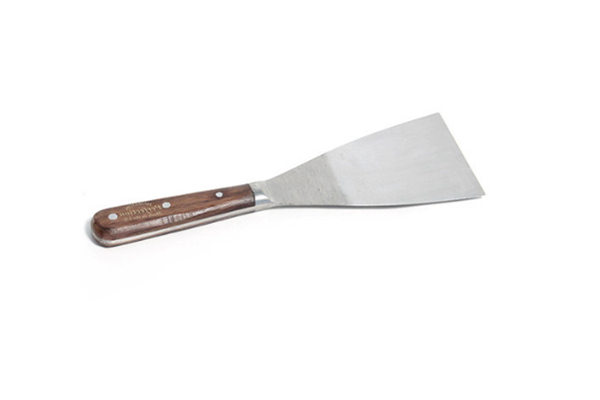A filling knife is a fundamental tool in the world of home improvement and repair. For both professionals and DIY enthusiasts alike, it offers precision and flexibility in a variety of applications, particularly in preparing surfaces for painting or finishing. With its thin, flat blade, the filling knife is an ideal tool for filling cracks, smoothing over imperfections, and ensuring surfaces are even. This article will explore the specific uses of a filling knife, how it differs from similar tools and tips on getting the best results when using it.
Understanding the Filling Knife
A filling knife is a handheld tool with a long, flexible blade typically made from stainless steel or carbon steel. Unlike a putty knife, which has a stiffer, often shorter blade, a filling knife is designed to be slightly more flexible. This flexibility allows it to apply filler compounds like joint compounds or spackling paste in thin, smooth layers that adhere well to surfaces.
While filling knives come in various widths, a standard blade width for general-purpose filling is about 2-4 inches. Wider blades are often used for large surfaces, such as walls, while narrower ones are ideal for smaller, more detailed tasks.

Primary Uses of a Filling Knife
1. Filling Cracks and Holes
One of the primary uses of a filling knife is to fill cracks and holes in surfaces like walls, ceilings, and wooden furniture. For example, when preparing a wall for painting, you may encounter small nail holes or cracks in the plaster. Using a filling knife, you can apply a filler (like spackle, plaster, or wood filler) to these imperfections. The blade’s flexibility allows you to push filler deep into cracks and crevices while spreading it evenly across the surface.
This step is critical for achieving a smooth, professional finish, as even the smallest imperfections can become more noticeable after painting. By using a filling knife to ensure that the filler is level with the surrounding surface, you can reduce the need for excessive sanding and avoid having uneven patches on your final finish.
2. Smoothing and Leveling Surfaces
In addition to filling cracks and holes, a filling knife is essential for smoothing and leveling filler over larger areas. For instance, if you’re repairing a damaged section of drywall, the filling knife can help apply joint compound over a wider area, blending it into the surrounding wall. Its flexibility allows it to glide over the surface, creating a flat, even layer that requires minimal sanding after it dries.
This tool is also helpful for smoothing the joints between drywall panels. By feathering the edges of the joint compound with a filling knife, you can achieve a seamless surface that looks continuous, making it especially useful in preparing walls for painting or wallpapering.
3. Applying Skim Coats
For larger repair jobs or refinishing surfaces, the filling knife is ideal for applying a skim coat – a very thin layer of joint compound or plaster over an entire surface. Skim coating is a technique used to create a uniform, smooth surface, particularly when repairing heavily textured walls or surfaces with significant imperfections.
With its thin, flexible blade, the filling knife can spread a thin, even layer of compound across the entire area, filling minor scratches, dents, or texture variations. This is especially useful when refinishing walls or ceilings that have become uneven over time or due to previous repairs.
4. Woodworking and Furniture Repairs
A filling knife also comes in handy for woodworking and furniture repair. In furniture restoration, for example, filling knives are often used to apply wood filler to cover dents, scratches, or gaps in wooden surfaces. The thin, flexible blade ensures the filler is applied precisely and evenly, allowing for an invisible repair once sanded and stained or painted.
Wood fillers used with a filling knife can also help restore molding, door frames, and window sills, making the filling knife a versatile tool for any project that requires smoothing out surfaces and filling imperfections.
Tips for Using a Filling Knife Effectively
- Choose the Right Size: Select a filling knife width appropriate for your project. Wider blades are ideal for large surfaces, while narrow blades offer better control for detailed work.
- Use Smooth, Even Strokes: When applying filler, use smooth, even strokes to spread it over the surface. Avoid applying too much pressure, as this can lead to uneven application.
- Angle the Blade Properly: Keep the blade at a slight angle to the surface to ensure an even layer of filler. This helps to avoid gouging or removing too much filler from the applied area.
- Work in Layers if Necessary: For larger or deeper cracks, it’s best to apply the filler in thin layers, allowing each one to dry before applying the next. This reduces shrinkage and cracking as the filler dries.
Filling Knife vs. Putty Knife: What’s the Difference?
While they may look similar, filling knives and putty knives serve slightly different purposes. A putty knife typically has a shorter, stiffer blade, which is more suited for scraping tasks or applying thick layers of putty or adhesive. In contrast, a filling knife’s thinner and more flexible blade is designed for applying thin, smooth layers of filler to achieve an even surface.
Conclusion: The Versatility of the Filling Knife
In summary, a filling knife is an invaluable tool for anyone involved in home improvement, from patching small wall holes to applying skim coats for a flawless finish. By allowing for smooth, precise application, this tool helps create surfaces ready for painting or other finishes. Whether you’re tackling large drywall projects or intricate furniture repairs, a filling knife is an essential tool that can make the difference between a rough job and a professional-looking result.
Post time: 10月-25-2024






